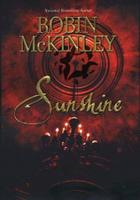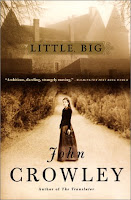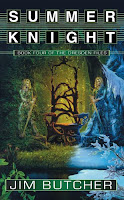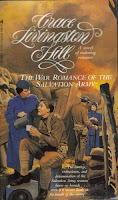What cost is too high for Peace? This book presents a world ruled by the "Peace Authority", a group who created a new technology that allowed them to enapsulate anything or anyone that they deemed dangerous to mankind (e.g., nuclear weaponry and the people with the power to use it), in an impervious, reflective "bobble." Now, fifty years later, the world is a wild, feudal land with little 'civilized' government in the ruins of the cities of California (large portions of the population were destroyed by a bio-engineered plague around the time the Peace Authority took over). Innovative new technology is being designed and created by the "Tinkers," family groups, and they rely on algorithms designed by the elderly Paul Naismith. When Paul sees a nearby bobble burst and makes the discovery that the people using the technology didn't really understand it to begin with, he uses his wits, his new apprentice, and his Tinker allies to wage war on the Peace authorities who have tried to contain anything "dangerous" in humanity.
In their attempts to keep humanity from self-destructing, the leaders of the Peace effort destroyed any government that might have been capable of resisting them, and they keep any new governments or technologies from progressing far enough to become a threat. The result is that they are keeping all of humanity in a feudal state and stifling innovation; their own technology has barely progressed from what they were using fifty years before, which was plenty when they were the only one with the all-powerful bobble technology. There are also subtle suggestions that gender roles and equality have regressed in this time; one of the most clever and successful agents working for the Peace Authority is a woman, and her place and authority is questioned by many of those around her, yet she is fiercely loyal to the Peace Authority. The Tinker families are very patriarchal, and women aren't allowed to be involved much in the technical work or in the big decisions. This state of affairs is highlighted by the contrast with Allison Parker, a woman from fifty years before....
Some of the most interesting ideas are about creativity - Paul's insight into the way bobbles actually work gives him the capability to use bobbles defensively instead of only for attack. Similarly, the Tinker technology is much more sophisticated than the Peacers suspect-- partly because they haven't been developing their own technology, and even seem to have lost some understanding of the old technologies they use that have kept them dominant. For one thing, the Tinker tech is much more energy efficient-- because they had such limited resources, they figured out a way to adapt.
I found this to be an exciting book, and very readable (although it took me a while to get engaged and really drawn in), but there are a lot of ideas here that are quit thought-provoking.
| Title: | The Peace War |
|---|---|
| Author: | Vernor Vinge |
| Date published: | 1984 |
| Genre: | Science Fiction |
| Number of pages: | 304 |
| Notes: | recommended and loaned by Levi |




























